0 Comments on Homeward bound - via Hong Kong as of 4/5/2012 6:41:00 AM
Day 2 began after a really, really restful sleep here at the Harbour Grand at North Point, a bed that was large and smooth and soft, and then a scrumptious hotel breakfast. Thanks to Sam (festival volunteer) for meeting us and delivering us safely to the Central Library. We have never been to the library in all the trips here so it was a thrill to do so this time ... although I didn't really get to look inside the library. This morning was spent in the auditorium for my Meet the Author talk. This morning's session was much about being a writer for digital creations as well books in the traditional form. What a wonderful time and the students asked some really great questions about digital work. It took a bit of work but eventually the questions started flowing.  | | the ONLY time i stood at the lectern |
 | | attentive listeners |
 | | with students from Christian Alliance College, Tuen Mum |
Library session done then it was back to the hotel to gather my thoughts before a drive out to the New Territor

By: AlexM,
on 1/23/2012
Blog: OUPblog
( Login to Add to MyJacketFlap)
JacketFlap tags:
Buddhism, Asia, hong kong, monk, *Featured, heart of buddha, James Carter, tanxu, tanxu’s, china, Religion, Add a tag
In Heart of Buddha, Heart of China: The Life of Tanxu, a Twentieth Century Monk, James Carter traces the life of Tanxu, an unknown but extraordinary Buddhist monk. Defined by a desire for a desire for an activist Chinese nationalism that maintained the nation’s cultural and social traditions Tanxu’s life story portrays twentieth century China from empire to republic, through war, famine, and revolution.
A century ago, Tanxu used his temples to establish physical links between Buddhism and Chinese nationalism. At the same time, though, he was guided by the belief that the physical world was illusory. The title of his memoir, “Recollections of Shadows and Dust,” uses a common Buddhist phrase meant to convey the impermanence and illusion of the material world, hardly the theological emphasis one might expect from a man who transformed cityscapes with his work in brick and mortar. I tried to understand this apparent paradox as I researched Tanxu’s career, but my connection to him remained impersonal, even distant, and strictly academic.
This all changed with the unexpected series of events that led me to the Bronx. My research turned up a commentary that Tanxu had written on the Heart Sutra (a Buddhist sutra is a sacred text, usually purporting to record the spoken teachings of the historical Buddha). This brief and very popular text includes the famous construction “form is emptiness; emptiness is form.” Tanxu’s commentary was translated into English and widely read by Western Buddhists. One morning from my office in Philadelphia I emailed the Young Men’s Buddhist Association (YMBA), in New York, to request a copy. They were happy to comply, but more interesting was this aside in their response: “By the way…[our] Master Lok To is a dharma heir disciple of Master Tanxu.”
…
Tanxu and Lok To worked together closely during the 1950’s and Lok To came to North America with Tanxu’s encouragement. He settled in the Bronx at the invitation of local Buddhist laity, and established the Buddhist Association of the United States there in 1964. Ten years later, he moved to his current location, on Davidson Avenue and founded the Young Men’s Buddhist Association as a center for his translation work. There he has been for nearly forty years.
…
Sitting with Lok To, Lu Bin (a young nun), and Hoi Sang Yu (a lay Buddhist who would become one of my most important guides through Tanxu’s world), I share my interest in Tanxu, and what I know about him. I’ve been to Harbin, and Yingkou, and Changchun, places they’ve never visited. Had I been to Qingdao, they wanted to know? Not yet. But that was the Master’s most important temple – I had to visit there: they could arrange it. They could coordinate my travels to most of the important stops on Tanxu’s itinerary, including Ningbo, where Tanxu studied to become a monk, and Tiantai Mountain, where his sect of Buddhism was established 1,100 years ago. Lok To was formally the abbot of Chamshan Temple in Hong Kong, where Tanxu’s remains were interred. I was welcome there anytime.
…
The moment was exciting, but also unsettling. I am by training and disposition an academic: keen to observe, less eager to participate. Journalists are warned to report, not to become, the story. Was I not risking just this by accepting invitations to temples and posing before Tanxu’s memorial shrine? And there was the question of faith. I make no claims for or against the beliefs that Tanxu, Lok To, and the other monks shared. Did I belong here?
Five months later, I stand in a mountainside clearing overlooking Clearwater Bay in Hong Kong’s New Territories. A white stupa housing Tanxu’s earthly remains gleams in the tropical sun. It is a beautiful scene of green cliffs plunging into the azure waters of the South China Sea. As I contemplate the view, a monkey em
  Tofu Quilt Ching Yeung Russell Tofu Quilt Ching Yeung Russell
Secret Wish
I remember Mr. Hon
once said that
a person should see more things
and open his eyes
if he wants to write a good story.
Ma cannot afford to send me off
to see things.
So I decide that
when I grow up,
I will not marry a doctor,
or a lawyer,
or a teacher,
or a businessman.
I will marry
a bus driver,
who can drive me everywhere
to see the world
and it will be
free.
And he must look like
Mr. Hon.
Tofu Quilt is a semi-auto-biographical verse novel about growing up in Hong Kong in the 50s and 60s and wanting to become a writer. Most of the poems focus on her relatives insisting that she shouldn't have big dreams or so much education, because she's a girl (her mother very much disagrees and insists that boys and girls are the same), reading books, or her trails and tribulations with various writing teachers over the years.
There isn't much of a plot, but it is a nice book especially for its pictures into day-to-day life in mid-century Hong Kong. The book shines when Ying is listening to the old ladies gossip at the end of the day or describing the flower market or the foreign tourist taking photos of drying laundry.
ARC Provided by... the publisher for review consideration
Links to Amazon are an affiliate link. You can help support Biblio File by purchasing any item (not just the one linked to!) through these links. Read my full disclosure statement.

By: Maryann Yin,
on 3/21/2011
Blog: Galley Cat (Mediabistro)
( Login to Add to MyJacketFlap)
JacketFlap tags:
Bi Feiyu, Translated Lit, Howard Goldblatt, Man Asian Literary Prize, Sylvia Li-chun Lin, Three Sisters, Awards, China, Houghton Mifflin Harcourt, Hong Kong, Add a tag
 Chinese novelist Bi Feiyu (pictured, via) has won the 2010 Man Asian Literary Prize for his novel, Three Sisters. The author accepted the award and $30,000 in prize money during a ceremony held in Hong Kong. Chinese novelist Bi Feiyu (pictured, via) has won the 2010 Man Asian Literary Prize for his novel, Three Sisters. The author accepted the award and $30,000 in prize money during a ceremony held in Hong Kong.
The novel’s translators, Howard Goldblatt and Sylvia Li-chun Lin, split a $5,000 award. Houghton Mifflin Harcourt published an English translation of Three Sisters last August.
Here’s more from the press release: “The Man Asian Literary Prize was founded in 2007. It is an annual literary award given to the best novel by an Asian writer, either written in English or translated into English, and published in the previous calendar year. The judges choose a longlist of 10 to 15 titles announced in December, followed by a shortlist of 5 to 6 titles announced in February, and a winner is awarded in March.” (via Shelf Awareness)
New Career Opportunities Daily: The best jobs in media.
Cheers for the last day of january and the first 31 days of 2011! Heyoooo! This month has unfolded in ways unimagined and unpredictable and just plain magical. I'm off to a solid 31 days of growth and understanding not the new but the already known. I feel ready to jump back into work not because the hunger for travel has been satiated but because of restlessness. Ironic. I still have a solo adventure in me. It's not a knock against Varnum or anything but I do crave the self-sufficiency, ultimate vulnerability and limitless freedom. I feel like this trip was to prove I could travel via business funds. The next will be to simply do it the way I love.
I think this lovely trip to hong kong (which I'll explain in detail w photos later) was the kick in the butt i needed to remember why I make and save money. It's not for an eventual downpayment on something expensive, but to spend on something vague and intangible... Adventure!!
I've noticed that this trip is quite different than others. First and the most obvious, I'm not traveling by myself. Second, I'm not staying in Asia for more than 6 months (dawwww major sad face). Third, I've listened to no music on this trip. And last, I've got my iPhone. Part 'wah wah' and part 'oh sweet'.
Before I go on I'd like to note that hong kong is unlike any city/state I've ever been. In a good way! Elements of it remind me of new york city (diversity, food), Tokyo (mrt, organization, near cleanliness), Mumbai (the crowded alleys and living) and none of it reminds of mainland china. I'm continuously amazed that my nostalgia for the Philippines has been cured by hearing tagalog or some Philippine dialect around me. Most people speak English (lazy American dang). They even have their own version of teh tarik! Gahhhh... I had some with a toasted buttered brioche w sweetened condensed milk drizzled on top. Oh brother what a world!
I have to say having my iPhone is kind of a buzz kill. I should have self control but there is just free public wifi everywhere! Trying to figure out where I am via gps vs squinting at street signs and trying to match characters and foreign words on a map... Oh I kind of miss the simpler times. I feel like I'm cheating. My old travel sketch books used to have travel notes, directions, hastily scrawled maps in between the sketches. This one's pretty clean and orderly. Having the phone definitely has its perks like not paying to use an old computer in a coffee shop or hostel lobby. But there is charm to complaining about slow internet or getting that last email out before times run out. I mean, i left america to be in a place completely different so does it count if i bring the luxuries with me? I pride myself in sleeping in cheap hostels with a backpack's worth of clothes, showering with a bucket of cold water but having this fancy phone, i feel, undoes all that. I cant hate it entirely though because i am blogging from my phone (but sadly can't post pictures lamecore fest 2011). I can chat with my friends, check on my etsy and business emails. So I wonder if that's a compromise I have to make to maintain a functioning business as I travel. Shrug. Perhaps!
Ok this is getting long (that's what she said!). Skeedaddle yankee doodle.
Greetings! I just work up from a 7 hour nap. Let that be a lesson to you to turn your phone off silent mode if you want to hear your alarm. Dang.
It's okay though. My headache has disappeared and I no longer feel exhausted from a 20 hr flight and 6 hours of wandering Kowloon like a zombie because the hostel room wasn't ready yet. So far, we've experienced the growing festivities that is the Chinese new year. We actually leave at the turn of the new year but are deeply considering going to Disneyland hk on our way out since it's on the way to the airport. That and I friggin love disneyland. we passed a sign on the highway that just had mickeys silhoutte head and an arrow suggesting Disneyland was the next exit. Awesome. I respect brevity in universally understood shapes.
We spent the early morning wandering through kowloon park. I love seeing all the old folk doing tai chi. I tried to draw them but found it incredibly difficult because one, I'm rusty and two, it's a challenge to sketch a defining key position because there is none! You know the pinnacle moment in a baseball pitch, someone running, etc. but that's not really the case with tai chi. It's all fluid, equally seeming significant poses. Ill keep practicing.Maybe I'll start doing yoga next to them. Whuttup playaaaa!
It's such a different experience walking around w James who is blond, tall and blue-eyed. I really love traveling in asia because I have an ability to blend in! But dang. James. Buzz kill. Tailored suit sir? Rolex watch, copy watch, sir? Every single time we step out! O brother. I also wonder if we look like a couple where Im the Asian girl he's saving from poverty in exchange for her youth and great wife abilities. And I'm in it for the cash money dolla dolla billz.
On a random note, Im very glad I do yoga. The flexibility skillz came in handy on the plane. A major buzz kill on long flights is the blood circulation issue from sitting for hours. My feet get so swollen I start to doubt if I'll ever fit into my shoes again! So here and there I would stretch my legs up perpendicular to the floor. I felt a little self conscious with everyone seeing my orange snoopy socks but hey! Beats feeling like you have fat feet.
 Tonight I leave for Hong Kong. Strangely, I'm not too excited. Most people seem to be more excited than I am. I think it's because I have work on my brain. Tonight I leave for Hong Kong. Strangely, I'm not too excited. Most people seem to be more excited than I am. I think it's because I have work on my brain.
I gotta visit Modern Mouse for an inventory restock, mail out a box of plush to NJ for a toy art exhibit, & prep my sister for maintaining my etsy shop. Oh & pack! These are all wonderful things but it's incredibly overwhelming to only have a day to accomplish it all. I must say it's very strange having to delegate tasks & modify my system so that someone can easily step in & take over. It's definitely a good adjustment & a sign that my business is growing. I think once I get all the business stuff outta the way, it'll be smooth sailing. I'll put on some Community, pack & drink Pinot Noir until it's time to fly.
On the drive from LA to San Jose, James asked me what my intentions were for the trip. This is something Karen suggested two nights ago and it made me really happy that James asked me before I could ask him. My intentions: to rediscover and experience that wonder, openness and overwhelming inspiration that comes from wandering a new world. It's been 8 months since I got back from the Philippines and I can feel myself getting comfortable in my American ways. I gotta shake things up again! Feel unsettled & unsatisfied and reconnect to my art. This trip comes at a good time & a marker that I can still self-finance my travels to foreign countries. LIVE THE DREAM!
Oh man... I didn't even get to finish writing but I gotta go! SEEEYAAHHHH
I used a filter on this photo for added ridiculousness. Like, why would you want to make that look artsy? I don't know. Because I can.
I can't tell if I'm simply burnt out from December or if LA makes me lazy. Either way my productivity hasn't been at its usual high. Business is also a bit slower but it's times like these I have to remind myself not to be discouraged by slowness. Instead I have to think of them as opportunities to do personal projects. My resolution for my birthday year is to find stability to counter & compliment the prior year's movement. I seem to still be moving around a lot. Oops!
On that note, I'm going to Hong Kong!!! So expect some adventure/travel posts in the near future. I haven't been in another country in 8 months and eek, that's far too long. I bought the ticket with James on Christmas Eve & it was probably the best gift I could have given myself in light of the holiday stress & intense work. Hopefully after Hong Kong I'll be ready to jump into the work.
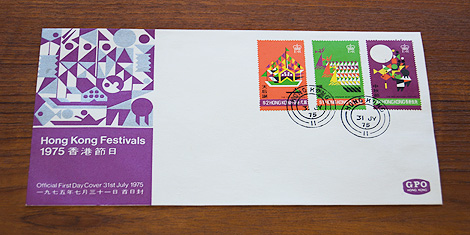
1975 Hong Kong festivals - official first day cover and stamp set designed by Tao Ho
Tao Ho is a Hong Kong-based architect, designer, teacher, and writer. He studied under Sigfried Giedion and Josep Lluís Sert at Harvard’s Graduate School of Design and worked with Bauhaus founder Walter Gropius at the Architects Collaborative. In 1975, Tao Ho designed this first day cover and stamp set to commemorate Hong Kong’s Tin Hau, Dragon Boat, and Mid-Autumn festivals.
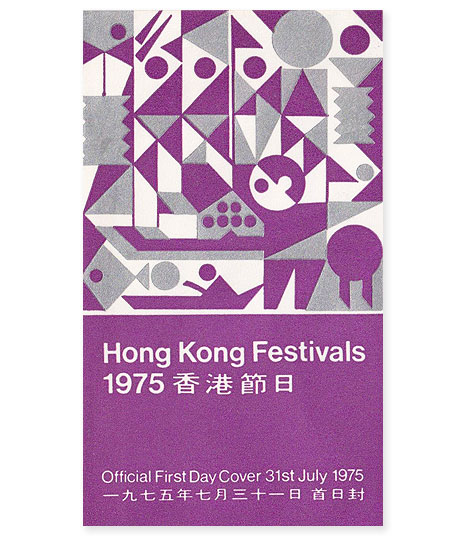
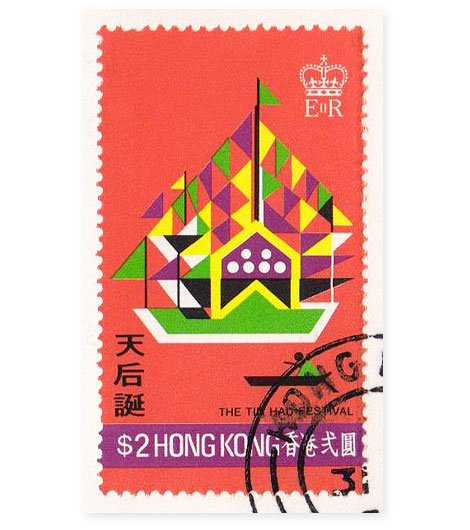
Tin Hau, Goddess of the Sea, is celebrated as the protector of fishermen and sailors. During the Tin Hau festival, fishing boats covered with colored streamers and flags sail through Joss House Bay in Sai Kung.
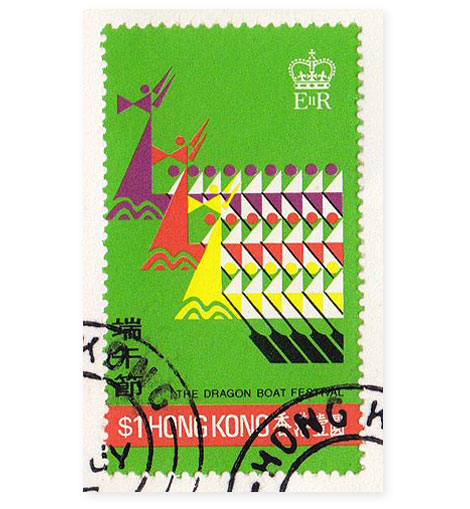
The Dragon Boat festival features teams of up to eighty oarsmen who race against one another in long wooden ships.
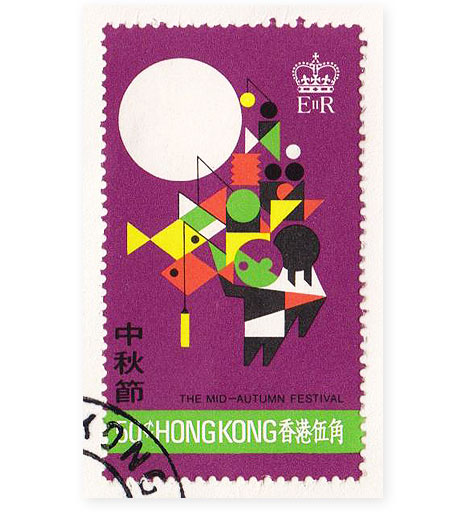
In the 14th century, a Chinese man named Liu Bowen planned to rebel against the Mongol overlords. Liu organized this uprising by concealing the message, “Rise against the Tartars on the 15th day of the 8th moon,” inside mooncakes (pastries with a lotus seed paste filling and a crust made with salted duck egg yolks). Mongols didn’t eat mooncakes, so Liu’s secret message was spread across the land and the rebellion was a success. The Mid-Autumn festival, which falls on the autumn equinox, when the moon is at its brightest, celebrates Liu’s uprising. Traditional festival activities include eating mooncakes outside under the moon, wearing pomelo rinds on one’s head, and carrying brightly lit lanterns.
——————
Also worth checking: 1966 Norway first day cover.
Not signed up for the Grain Edit RSS Feed yet? Give it a try. Its free and yummy.
——————
No Tags Share This
Congrats to Jenny Eng. She is the winner of the Kevin Dart giveaway.
©2009 Grain Edit 

By: Aline Pereira,
on 1/20/2009
Blog: PaperTigers
( Login to Add to MyJacketFlap)
JacketFlap tags:
M Authors, Hong Kong, M Title, Chinese Zodiac, Kam Mak, lunar year, My Chinatown, Lunar New Year, Children's Books, Picture Books, Illustrators, The Tiger's Bookshelf, Add a tag
 When a writer and an illustrator blend their gifts to create a picture book, that is a very special kind of magic. When a picture book comes into being because one person has been both author and illustrator, using each of these arts with equal skill, that goes beyond magic into the realm of miracles. When a writer and an illustrator blend their gifts to create a picture book, that is a very special kind of magic. When a picture book comes into being because one person has been both author and illustrator, using each of these arts with equal skill, that goes beyond magic into the realm of miracles.
Kam Mak has created one of those miracles with My Chinatown–a book that is impossible to ignore because of his glowing, colorful paintings that dominate the front and back covers and the vivid images within that he has created with his words.
A small boy scuffs through ”drifts of red paper,” ”a snowfall the color of luck,” missing Hong Kong as he faces New Year in a place that is not yet home. “So many things got left behind,” he says, “a country/a language/a grandmother,” and the simple poetry in this statement aches with loss, expressed in new words that “taste like metal in my mouth.”
The words and paintings follow him through the year as he explores his new surroundings, makes friends, finds familiar sights in a place that slowly becomes familiar as well. When the New Year comes around again, with its “lions in the street outside,” he’s eager to be nearby watching them “shaking their neon manes.”
Although this book was wonderfully reviewed by PaperTigers’ contributor Jessica Roeder when it was first published in the spring of 2002, I was so enchanted by it when I recently found it in a Bangkok library that I had to bring it home with me to write about the treasure that had come into my hands. It’s a book that addresses the joy of childhood, the pain of leaving family members when coming to a new country, the excitement of exploring the unfamiliar and making it your own place. Each page of text has its own painting, and the words combine with Mak’s masterful use of color and light to make this book unforgettable.
Anyone living near a United States post office can own a small piece of Mak’s art for the price of a postage stamp–he has designed a set of stamps that illustrate the Chinese Zodiac and are released annually, one at a time as the lunar New Year begins. Happy Year of the Ox, everyone!

This is my first character for our Christmas story layout. Her name is Chyna.
Chyna is around 7 or 8. Chyna is awe struck by the lights, bells and whistles of the
Christmas season. She has not a clue as to what to purchase for her
pen pal Lysan Tong who lives in Hong Kong.
|































Wonderful, Vanessa! I love Chyna, she's got the cutest face and outfit. I also love how you left the background simple, just lines and a few colors, very bare but perfect. The attention is all on Chyna and her thoughts.
I have to say, I hope she heads to the art supplies store! :-)
wow, really beautiful illo! Chyna's so lovely and your colours are alive in this background.
Chyna is beautiful! The colors you used are great & I too like the simplicity of the composition. Her expression is wonderful.
Nice illo! :)
she is adorable... I am totally loving her scarf! =)
Looks like my Posey has the same stylista.
Thanks for sharing.
Very fun colors. I love the distorted perspective on Chyna. It makes her feel like she's a little off-balance as to how many stores and choices she's facing. Good job.
That's beautiful, Vanessa!